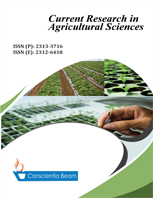Growth response of nursery raised cashew seedlings to light clay soil amended with inorganic fertilizers
DOI:
https://doi.org/10.18488/cras.v11i1.3776Abstract
This study aims to evaluate the performance of light clay soil amended with inorganic fertilizer in the early cashew seedling growth phase. The two month experiment was set up in a screenhouse at the Cocoa Research Institute of Nigeria. The experiment was laid out in Complete Randomized Design. The first factor consists of cashew biotypes (large and medium) while the second factor includes 2 fertilizer combinations (Urea and Single-Super-Phosphate (SSP)). The treatments include Large + 0 (L0 as control), Large + 40kg/ha Urea + 30kg/ha SSP (L1), Large + 80kg/ha Urea + 60kg/ha SSP (L2), Medium + 0 (M0 as control), Medium + 40kg/ha Urea + 30kg/ha SSP (M1), and Medium + 80kg/ha Urea + 60kg/ha SSP (M2). We applied the treatments one month after sowing. One nut seed per nursery polythene bag was sown using a light clay soil growing medium. The physicochemical properties of the growing media were analyzed while data on seedling emergence, growth parameters, and % seedling survival were recorded. Data was analyzed using Analysis of Variance, and treatment means were separated using Duncan Multiple Range Test (DMRT) at 0.05% probability level. Seedlings with no fertilizer treatments, L0 (4.5) and M0 (4.0), had the best seedling vigour, while L2 (2.5) and M2 (2.0) had the lowest, respectively, in a 5-grade score. The control, jumbo, and medium biotypes recorded a survival rate of 100%, 33.33%, and 16.67%, respectively. The application of the inorganic fertilizers to the light clay soil used negatively influenced cashew seedling growth.

